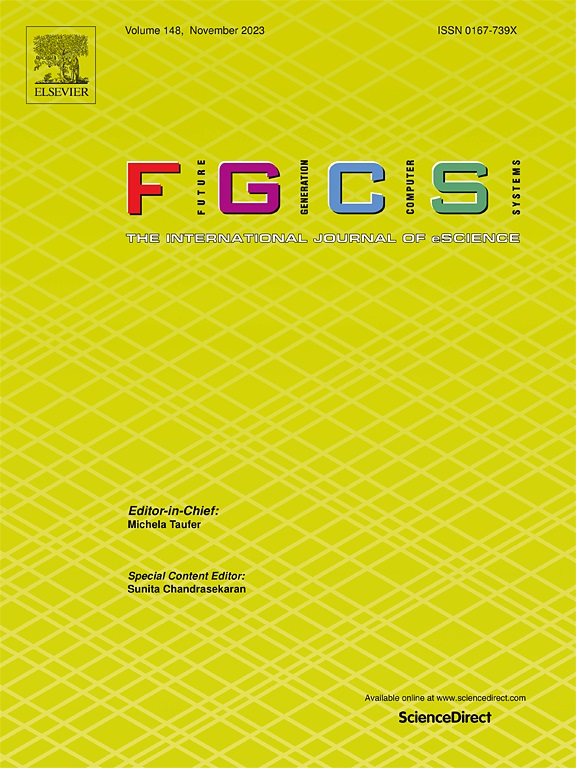Towards dynamic virtual machine placement based on safety parameters and resource utilization fluctuation for energy savings and QoS improvement in cloud computing
IF 6.2
2区 计算机科学
Q1 COMPUTER SCIENCE, THEORY & METHODS
Future Generation Computer Systems-The International Journal of Escience
Pub Date : 2025-04-09
DOI:10.1016/j.future.2025.107853
引用次数: 0
Abstract
The majority of studies regard virtual machine placement (VMP) as a multi-dimensional bin packing problem. The most common solution is to place as many virtual machines (VMs) on physical machines (PMs) as possible in order to improve the overall resource utilization of the cloud data centers (CDCs). However, it brings some obstacles for the working performance of VMs and the quality of service (QoS) for CDCs, such as (i) performance degradation between running VMs since resources are contested and (ii) resource wastage since single-dimensional resources fail to allocate resources for a new VM instance. In addition, we find that if we do not capture resource request fluctuation for tasks running on VMs, it will increase the probability of underloading or overloading the PM, resulting in VM migration with more performance loss and service-level agreement (SLA) violation (SLAV).
In order to solve the above problems and further realize the objectives of energy savings, QoS guarantee, we introduce an enhancing QoS dynamic virtual machine placement (ESVMP) mechanism. It is based on balance deviation factor, safety factor, and fluctuation factor indicators, which optimize PM resource utilization while deploying VMs on PMs that have balanced and stable resource utilization and the ability to guarantee VMs’ working performance so as to guarantee the QoS of the CDC. In addition, to further reduce energy consumption, the ESVMP algorithm leverages energy-efficiency indicators. The results of extensive experiments conducted on the CloudSim simulator show that under the PlanetLab workload, the ESVMP approach is able to reduce the energy consumption, number of migrations, SLAV, and ESV of CDCs by 2.8%, 61.5%, 98.5%, and 98.7%, respectively, on average, compared with the LBVMP approach; and under the Bitbrains workload, the ESVMP approach can reduce the number of migrations, SLAV, and ESV of CDCs by 60.9%, 89.7%, and 89.8% on average, respectively, compared with the LBVMP approach.
基于安全参数和资源利用率波动的云计算节能和QoS改进动态虚拟机布局研究
大多数研究将虚拟机放置(VMP)视为多维仓包装问题。最常见的解决方案是在物理机(PM)上放置尽可能多的虚拟机(VM),以提高云数据中心(CDC)的整体资源利用率。然而,这给虚拟机的工作性能和云数据中心的服务质量(QoS)带来了一些障碍,例如:(i) 运行中的虚拟机之间因资源争夺而导致性能下降;(ii) 单维资源无法为新的虚拟机实例分配资源,造成资源浪费。此外,我们还发现,如果不捕捉虚拟机上运行任务的资源请求波动,就会增加 PM 负载不足或过载的概率,导致虚拟机迁移带来更多性能损失和违反服务级别协议(SLA)(SLAV)。为了解决上述问题,进一步实现节能和保证 QoS 的目标,我们引入了一种增强 QoS 动态虚拟机放置机制(ESVMP),该机制基于平衡偏差因子、安全因子和波动因子指标,在优化 PM 资源利用率的同时,将虚拟机部署在资源利用率平衡、稳定且能保证虚拟机工作性能的 PM 上,从而保证 CDC 的 QoS。此外,为了进一步降低能耗,ESVMP 算法还利用了能效指标。在 CloudSim 模拟器上进行的大量实验结果表明,在 PlanetLab 工作负载下,ESVMP 方法能够将 CDC 的能耗、迁移次数、SLAV 和 ESV 平均分别降低 2.8%、61.5%、98.5% 和 98.7%。在 Bitbrains 工作负载下,与 LBVMP 方法相比,ESVMP 方法能将 CDC 的迁移次数、SLAV 和 ESV 平均分别减少 60.9%、89.7% 和 89.8%。
本文章由计算机程序翻译,如有差异,请以英文原文为准。
求助全文
约1分钟内获得全文
求助全文
来源期刊
CiteScore
19.90
自引率
2.70%
发文量
376
审稿时长
10.6 months
期刊介绍:
Computing infrastructures and systems are constantly evolving, resulting in increasingly complex and collaborative scientific applications. To cope with these advancements, there is a growing need for collaborative tools that can effectively map, control, and execute these applications.
Furthermore, with the explosion of Big Data, there is a requirement for innovative methods and infrastructures to collect, analyze, and derive meaningful insights from the vast amount of data generated. This necessitates the integration of computational and storage capabilities, databases, sensors, and human collaboration.
Future Generation Computer Systems aims to pioneer advancements in distributed systems, collaborative environments, high-performance computing, and Big Data analytics. It strives to stay at the forefront of developments in grids, clouds, and the Internet of Things (IoT) to effectively address the challenges posed by these wide-area, fully distributed sensing and computing systems.

 求助内容:
求助内容: 应助结果提醒方式:
应助结果提醒方式:


